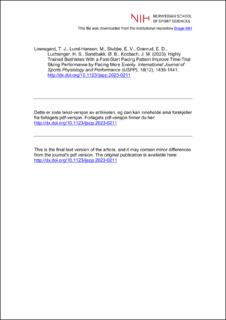| dc.contributor.author | Losnegard, Thomas Johansen | |
| dc.contributor.author | Lund-Hansen, Magne | |
| dc.contributor.author | Stubbe, Erland Vedeler | |
| dc.contributor.author | Granrud, Even Dahlen | |
| dc.contributor.author | Luchsinger, Harri Simon | |
| dc.contributor.author | Sandbakk, Øyvind Bucher | |
| dc.contributor.author | Kocbach, Jan Martin | |
| dc.date.accessioned | 2024-01-12T11:56:41Z | |
| dc.date.available | 2024-01-12T11:56:41Z | |
| dc.date.created | 2023-10-30T13:40:12Z | |
| dc.date.issued | 2023 | |
| dc.identifier.citation | International Journal of Sports Physiology and Performance (IJSPP). 2023, 18(12), 1435-1441. | en_US |
| dc.identifier.issn | 1555-0265 | |
| dc.identifier.uri | https://hdl.handle.net/11250/3111295 | |
| dc.description | I Brage finner du siste tekst-versjon av artikkelen, og den kan inneholde ubetydelige forskjeller fra forlagets pdf-versjon. Forlagets pdf-versjon finner du på humankinetics.com / In Brage you'll find the final text version of the article, and it may contain insignificant differences from the journal's pdf version. The definitive version is available at humankinetics.com | en_US |
| dc.description.abstract | Purpose: In sprint biathlon, a J-shaped pacing pattern is commonly used. We investigated whether biathletes with a fast-start pacing pattern increase time-trial skiing and shooting performance by pacing more evenly. Methods: Thirty-eight highly trained biathletes (∼21 y, 27 men) performed an individual 7.5 (3 × 2.5 km for women) or 10-km (3 × 3.3 km for men) time trial on roller skis with a self-selected pacing strategy (day 1). Prone (after lap 1) and standing shooting (after lap 2) stages were performed using paper targets. Based on their pacing strategy in the first time trial (ratio between the initial ∼800-m segment pace on lap 1 and average ∼800-m segment pace on laps 1–3), participants were divided into an intervention group with the fastest starting pace (INT, n = 20) or a control group with a more conservative starting pace (CON, n = 18). On day 2, INT was instructed to reduce their starting pace, while CON was instructed to maintain their day 1 strategy. Results: INT increased their overall time-trial performance more than CON from day 1 to day 2 (mean ± 95% CI; 1.5% ± 0.7% vs 0.0% ± 0.9%, P = .02). From day 1 to day 2, INT reduced their starting pace (5.0% ± 1.5%, P < .01), with reduced ratings of perceived exertion during lap 1 (P < .05). For CON, no change was found for starting pace (−0.8% ± 1.2%) or ratings of perceived exertion between days. No differences were found for shooting performance for either group. Conclusion: Highly trained biathletes with a pronounced fast-start pattern improve skiing performance without any change in shooting performance by pacing more evenly. | en_US |
| dc.language.iso | eng | en_US |
| dc.subject | cross-country skiing | en_US |
| dc.subject | GNSS | en_US |
| dc.subject | intermittent exercise | en_US |
| dc.subject | heart rate | en_US |
| dc.subject | rating of perceived exertion | en_US |
| dc.title | Highly Trained Biathletes With a Fast-Start Pacing Pattern Improve Time-Trial Skiing Performance by Pacing More Evenly | en_US |
| dc.title.alternative | Highly Trained Biathletes With a Fast-Start Pacing Pattern Improve Time-Trial Skiing Performance by Pacing More Evenly | en_US |
| dc.type | Peer reviewed | en_US |
| dc.type | Journal article | en_US |
| dc.description.version | acceptedVersion | en_US |
| dc.source.pagenumber | 7 | en_US |
| dc.source.journal | International Journal of Sports Physiology and Performance (IJSPP) | en_US |
| dc.identifier.doi | 10.1123/ijspp.2023-0211 | |
| dc.identifier.cristin | 2190019 | |
| dc.description.localcode | Institutt for fysisk prestasjonsevne / Department of Physical Performance | en_US |
| cristin.ispublished | true | |
| cristin.fulltext | postprint | |
| cristin.qualitycode | 1 | |
